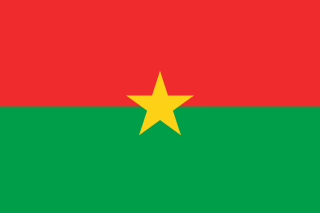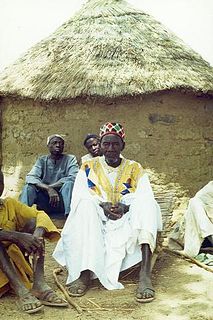
Burkina Faso is a landlocked country in West Africa with an area of 274,200 km2 (105,900 sq mi), bordered by Mali to the northwest, Niger to the northeast, Benin to the southeast, Togo and Ghana to the south, and the Ivory Coast to the southwest. It has a population of 20,321,378. Previously called Republic of Upper Volta (1958–1984), it was renamed Burkina Faso by President Thomas Sankara. Its citizens are known as Burkinabè, and its capital and largest city is Ouagadougou.

This article is about the demographic features of the population of Burkina Faso, including population density, ethnicity, education level, health of the populace, economic status, religious affiliations and other aspects of the population.

Ouagadougou is the capital of Burkina Faso and the administrative, communications, cultural, and economic centre of the nation. It is also the country's largest city, with a population of 2,415,266 in 2019. The city's name is often shortened to Ouaga. The inhabitants are called ouagalais. The spelling of the name Ouagadougou is derived from the French orthography common in former French African colonies.

Thomas Isidore Noël Sankara was a Burkinabé military officer, Marxist revolutionary, and pan-Africanist, who served as President of Burkina Faso from his coup in 1983 to his deposition and murder in 1987. Viewed by supporters as a charismatic and iconic figure of revolution, he is commonly referred to as 'Africa's Che Guevara'.

Jean-Baptiste Philippe Ouédraogo, also referred to by his initials JBO, is a Burkinabé physician and retired military officer who served as President of Upper Volta from 8 November 1982 to 4 August 1983. He has since mediated a few national political disputes and operates a clinic in Somgandé.

The music of Burkina Faso includes the folk music of 60 different ethnic groups. The Mossi people, centrally located around the capital, Ouagadougou, account for 40% of the population while, to the south, Gurunsi, Gurma, Dagaaba and Lobi populations, speaking Gur languages closely related to the Mossi language, extend into the coastal states. In the north and east the Fulani of the Sahel preponderate, while in the south and west the Mande languages are common; Samo, Bissa, Bobo, Senufo and Marka. Burkinabé traditional music has continued to thrive and musical output remains quite diverse. Popular music is mostly in French: Burkina Faso has yet to produce a major pan-African success.

The Mossi are a Gur ethnic group native to modern Burkina Faso, primarily the Volta River basin. The Mossi are the largest ethnic group in Burkina Faso, constituting 52% of the population, or about 11.1 million people. The other 48% of Burkina Faso's population is composed of more than 60 ethnic groups, mainly the Gurunsi, Senufo, Lobi, Bobo and Fulani. The Mossi speak the Mòoré language.

Ouahigouya is a town in northern Burkina Faso. It is the capital of the Yatenga Province and one of its subdivisions the Ouahigouya Department. It is also the biggest town in the Nord Region. It is the fourth largest city in the country with a population of 124,587 (2019) and is situated 182 kilometres (113 mi) north-west of Ouagadougou.

Yatenga is one of the provinces of Burkina Faso, located in the Nord Region of the country. In modern Yatenga, the most prominent city is Ouahigouya. This city served as the capital of the kingdom of Yatenga, a powerful kingdom out of the many Mossi kingdoms, but its influence decreased in the century following French colonisation. The city is famed today for being home to the Naba's compound and the tomb of Naba Kango.

The Mossi Kingdoms, sometimes referred to as the Mossi Empire, were a group of powerful kingdoms in modern-day Burkina Faso which dominated the region of the upper Volta river for hundreds of years. The largest Mossi kingdoms was that of Ouagadougou and the king of Ouagadougou known as the Mogho Naaba, or King of All the World, serves as the Emperor of all the Mossi. The first kingdom was founded when Dagomba warriors from the region that is present-day Ghana and Mandé warriors moved into the area and intermarried with local people. Centralization of the political and military powers of the kingdoms begin in the 13th century and led to conflicts between the Mossi kingdoms and many of the other powerful states in the region. In 1896, the French took over the kingdoms and created the French Upper Volta which largely used the Mossi administrative structure for many decades in governing the colony.
Articles related to Burkina Faso include:
The Gurunsi, or Grunshi, are a set of related ethnic groups inhabiting northern Ghana and south and central Burkina Faso.

Parfait-Louis Monteil was a French colonial military officer and explorer who made an epic journey in West Africa between 1890 and 1892, travelling east from Senegal to Lake Chad, and then north across the Sahara to Tripoli.
Zongoiri Natinga is a community in the Bawku West District of the Upper East Region of Ghana, to the northwest of a bend in the White Volta River.
The Kassena people are an ethnic group located along the northern Ghana and Burkina Faso border. They speak the Kassem language. Their king lives in the town of Tiébélé. The Kasenna are closely related to the people of Nankanni and were brought together to form the Kassena-Nankana administrative district in 1936. As of 2008 the (Kassena-Nankana) area comprises two districts: Kassena Nankana West and Kassena Nankana East.
The Yarse, also spelt Yarsé, Yarsin or Yarcin, are a people of Burkina Faso, living among the Mossi. The population in the mid-1990s was estimated at 190,000, of whom 90% were Muslims.
Naba Kougri was, according to the traditional order, the 36th Mogho Naba of Ouagadougou, the king of the Mossi people of Burkina Faso. He was the son of the previous Mogho Naba, Sagha II. He reigned from 1957 to his death on 8 December 1982.
Guimbi, sometimes Guimbé, Ouattara (1836–1919) was a West African ruler and military leader in what today is the country of Burkina Faso.
Naaba Kango or Naba Kango is known as the greatest of the rulers of Yatenga, an early modern kingdom in present-day Burkina Faso.











